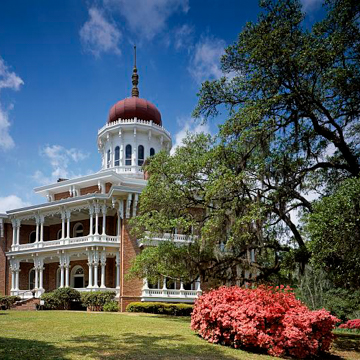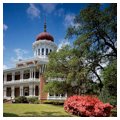The Civil War interrupted the construction of Longwood, the nation’s largest octagonal house. This unfinished Italianate building, crowned by an onion dome, was designed by Samuel Sloan of Philadelphia for Haller and Julia Williams Nutt. The Nutts owned several cotton and sugar plantations in Mississippi and Louisiana, worked by over 800 slaves. Haller Nutt had also developed the Egypto-Mexican strain of cotton that became popular in the Deep South. The Nutts were probably inspired to hire Sloan after seeing a similar design (“An Oriental Villa” Design Forty-Ninth) published in 1852 in Sloan's Model Architect, Vol. II. Correspondence between Sloan and Haller Nutt reveals that Sloan first visited Natchez in January 1860, and the following April, Nutt demolished the existing 1820s house on the property. Sloan sent northern masons and carpenters to build the house and had the millwork manufactured in Philadelphia. Addison Hutton, who later became an architect in his own right, was Sloan’s on-site supervisor. Sloan engaged furniture maker and retailer George Henkels to make the doors and produce a furnishings plan.
When the Civil War began in April 1861, most of the Northern workmen went home, although the Nutts were Unionists. Sloan was able to persuade a roofing tinner to come to Natchez during the early months of the war to complete the roof to keep the house dry until it could be finished. Haller Nutt completed the basement as a temporary home for his family, but after his death in 1864 these quarters became permanent. Julia Nutt died in 1897 and her descendants owned the unfinished house until 1968. An original lithograph prepared by Sloan's office illustrates the house as it would have looked had it been completed and finished in scored and penciled stucco and sanded paint. The entire house would have been tinted a stone color.
Today, the Pilgrimage Garden Club owns and preserves the house in its unfinished state and opens it daily. Original outbuildings include a brick privy, a frame carriage house, a deteriorated and altered frame kitchen building, and an adjacent two-story brick building with gable roof and full-width double-tiered gallery that is the Natchez District’s largest slave quarters building.




